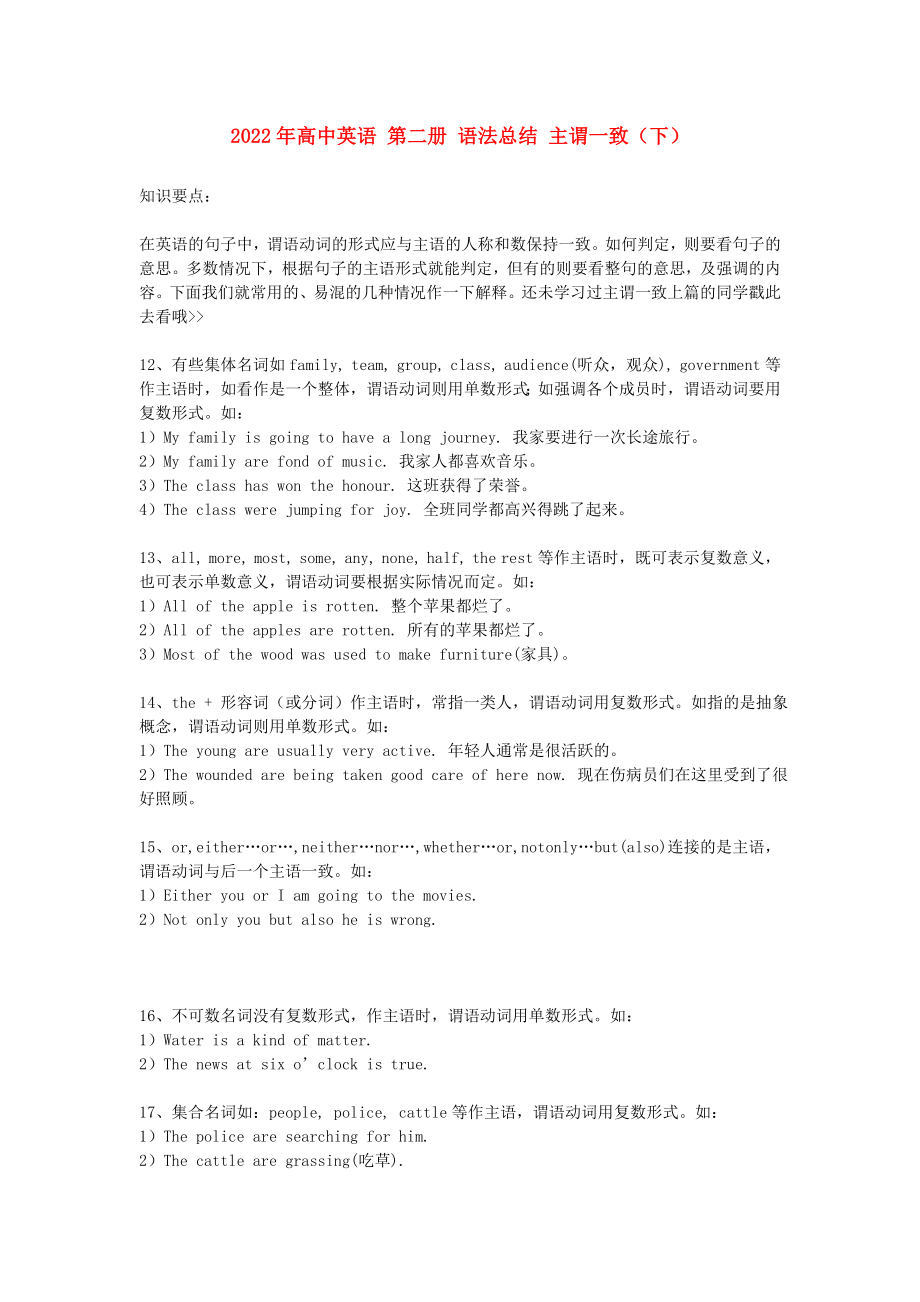《2022年高中英語(yǔ) 第二冊(cè) 語(yǔ)法總結(jié) 主謂一致(下)》由會(huì)員分享�����,可在線閱讀��,更多相關(guān)《2022年高中英語(yǔ) 第二冊(cè) 語(yǔ)法總結(jié) 主謂一致(下)(3頁(yè)珍藏版)》請(qǐng)?jiān)谘b配圖網(wǎng)上搜索�。
1、2022年高中英語(yǔ) 第二冊(cè) 語(yǔ)法總結(jié) 主謂一致(下)
知識(shí)要點(diǎn):
在英語(yǔ)的句子中��,謂語(yǔ)動(dòng)詞的形式應(yīng)與主語(yǔ)的人稱和數(shù)保持一致����。如何判定�����,則要看句子的意思���。多數(shù)情況下,根據(jù)句子的主語(yǔ)形式就能判定��,但有的則要看整句的意思�,及強(qiáng)調(diào)的內(nèi)容。下面我們就常用的���、易混的幾種情況作一下解釋�����。還未學(xué)習(xí)過(guò)主謂一致上篇的同學(xué)戳此去看哦>>
12、有些集體名詞如family, team, group, class, audience(聽(tīng)眾��,觀眾), government等作主語(yǔ)時(shí)�����,如看作是一個(gè)整體,謂語(yǔ)動(dòng)詞則用單數(shù)形式�����;如強(qiáng)調(diào)各個(gè)成員時(shí)�����,謂語(yǔ)動(dòng)詞要用復(fù)數(shù)形式�����。如:
1)My family is go
2��、ing to have a long journey. 我家要進(jìn)行一次長(zhǎng)途旅行���。
2)My family are fond of music. 我家人都喜歡音樂(lè)���。
3)The class has won the honour. 這班獲得了榮譽(yù)。
4)The class were jumping for joy. 全班同學(xué)都高興得跳了起來(lái)����。
13、all, more, most, some, any, none, half, the rest等作主語(yǔ)時(shí)���,既可表示復(fù)數(shù)意義�����,也可表示單數(shù)意義�,謂語(yǔ)動(dòng)詞要根據(jù)實(shí)際情況而定。如:
1)All of the apple is rotten.
3�、整個(gè)蘋果都爛了。
2)All of the apples are rotten. 所有的蘋果都爛了�。
3)Most of the wood was used to make furniture(家具)。
14��、the + 形容詞(或分詞)作主語(yǔ)時(shí)��,常指一類人��,謂語(yǔ)動(dòng)詞用復(fù)數(shù)形式�����。如指的是抽象概念���,謂語(yǔ)動(dòng)詞則用單數(shù)形式��。如:
1)The young are usually very active. 年輕人通常是很活躍的���。
2)The wounded are being taken good care of here now. 現(xiàn)在傷病員們?cè)谶@里受到了很好照顧。
15���、or,
4���、either…or…, neither…nor…, whether…or, not only…but (also)連接的是主語(yǔ),謂語(yǔ)動(dòng)詞與后一個(gè)主語(yǔ)一致�����。如:
1)Either you or I am going to the movies.
2)Not only you but also he is wrong.
16���、不可數(shù)名詞沒(méi)有復(fù)數(shù)形式�,作主語(yǔ)時(shí)�,謂語(yǔ)動(dòng)詞用單數(shù)形式。如:
1)Water is a kind of matter.
2)The news at six o’clock is true.
17���、集合名詞如:people, police, catt
5�、le等作主語(yǔ)�����,謂語(yǔ)動(dòng)詞用復(fù)數(shù)形式。如:
1)The police are searching for him.
2)The cattle are grassing(吃草).
18�����、population當(dāng)人口講時(shí)��,謂語(yǔ)動(dòng)詞用單數(shù)形式���;當(dāng)人們講時(shí)�����,謂語(yǔ)動(dòng)詞用復(fù)數(shù)�����。如:
1)The population of China is larger than that of Japan.
2)One third of the population here are workers.
19����、the number of + 名詞復(fù)數(shù)���,是表示“……的數(shù)字”�,作主語(yǔ)時(shí),謂語(yǔ)動(dòng)詞用單數(shù)形式���;a (
6、large/great) number of + 名詞復(fù)數(shù)����,表示許多,作主語(yǔ)時(shí)����;謂語(yǔ)動(dòng)詞用復(fù)數(shù)形式。
1)The number of the students in our school is increasing year after year.
2)A number of students have gone for an outing.
20����、means, politics, physics, plastics等作主語(yǔ)時(shí),謂語(yǔ)動(dòng)詞用單數(shù)形式��。
【專項(xiàng)訓(xùn)練】
1��、Nothing but cars ______ in the shop.
A.is sold
7��、B.a(chǎn)re sold C.were sold D.a(chǎn)re going to sell
2����、No one except Jack and Tom ______ the answer.
A.know B.knows C.is knowing D.a(chǎn)re known
3���、Seventy percent of the students in our school ______ from the countryside.
A.is B.a(chǎn)re C.es D.a(chǎn)re ing
4、______ of the money ______ used up.
A.Three-five, ar
8�、e B.Three-fifths, have been
C.Three-fifths, has been D.Third-fifths, is
5、The number of the people who ______ cars ______ increasing.
A.owns, are B.owns, is C.own, is D.own, are
6�、One of Marx’s works ______ written in English in the 1860s.
A.was B.were C.would be D.a(chǎn)re
7、The sheets for y
9�、our bed ______ washing.
A.needs B.a(chǎn)re needing C.want D.a(chǎn)re wanting
8、On each side of the street ______ a lot of trees.
A.stands B.grow C.is standing D.a(chǎn)re grown
9��、Some person ______ calling for you at the gate.
A.a(chǎn)re B.is C.is being D.will be
10����、All that can be eaten ______ eaten up.
A.
10、are being B.has been C.had been D.have been
(后設(shè)答案���,大家不要偷看哦~(*^__^*) 嘻嘻……)
KEYS
1��、A 因有連詞but�,所以謂語(yǔ)形式跟Nothing一致�����,用第三人稱單數(shù)�����。見(jiàn)講解4。
2�����、B 見(jiàn)講解4����。
3�����、B 見(jiàn)講解2��。
4���、C 見(jiàn)講解16�����。
5�����、C 定語(yǔ)從句看被修飾的先行詞:the number of作主語(yǔ)用單數(shù)形式�。見(jiàn)講解9,19�����。
6�、A 見(jiàn)講解1。
7��、C 見(jiàn)講解2�����。
8��、B 倒裝句�,要看后面的主語(yǔ)。見(jiàn)講解3���。
9�、B some person指“某人”是第三人稱單數(shù)���。見(jiàn)講解13��。
10�����、B 主語(yǔ)"all"指的是"food"�,所以代不可數(shù)名詞,是第三人稱單數(shù)���。見(jiàn)講解13�����。
 2022年高中英語(yǔ) 第二冊(cè) 語(yǔ)法總結(jié) 主謂一致(下)
2022年高中英語(yǔ) 第二冊(cè) 語(yǔ)法總結(jié) 主謂一致(下)

